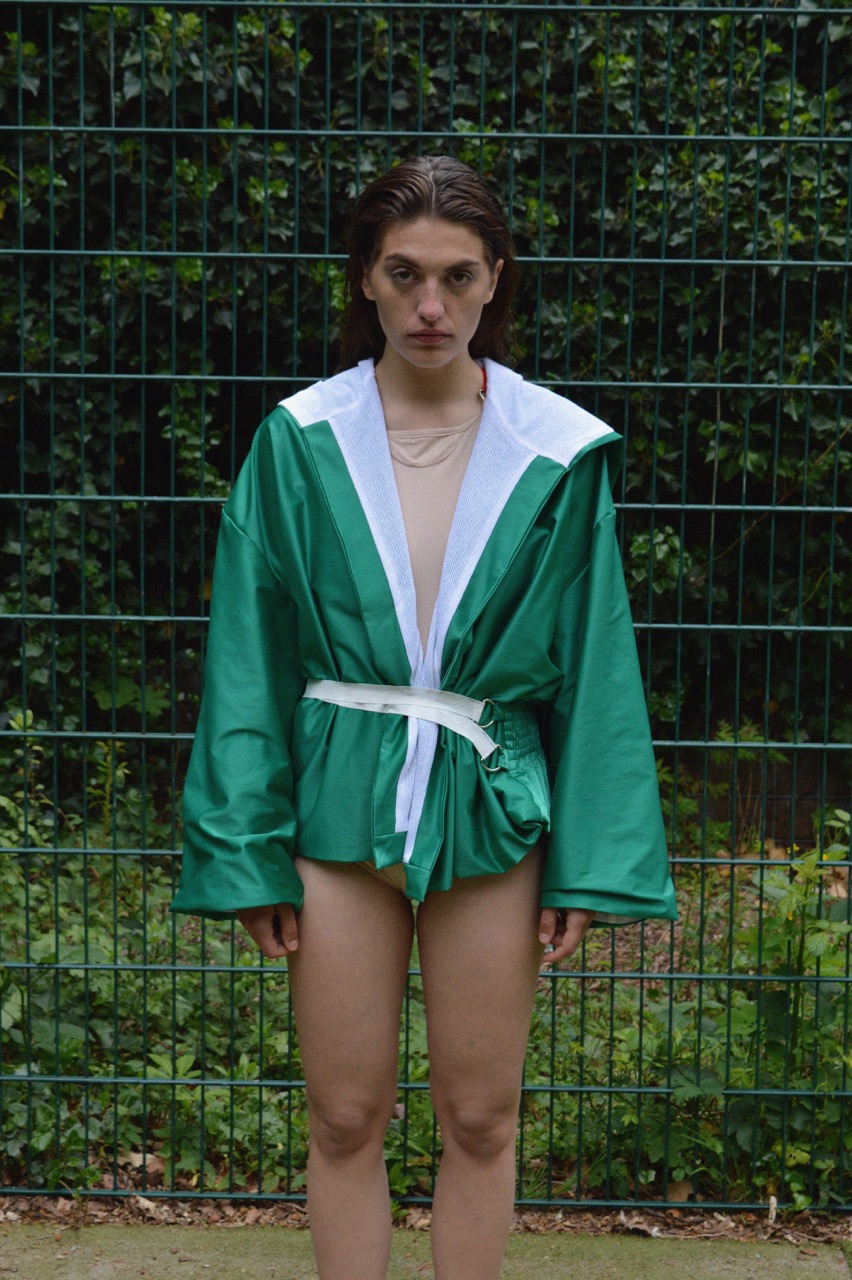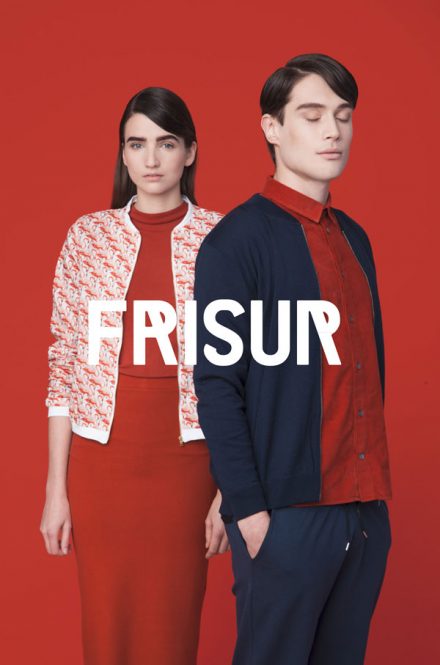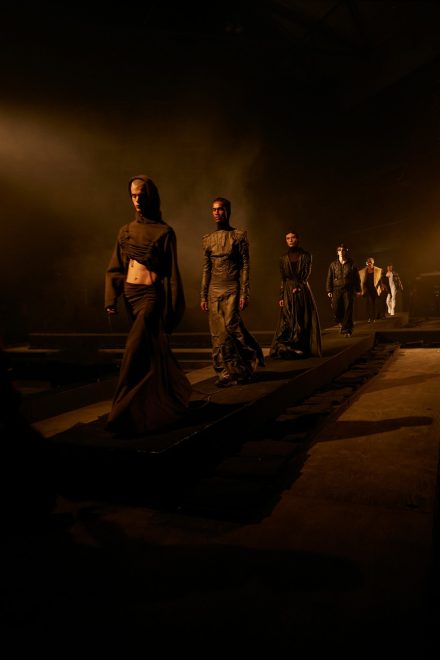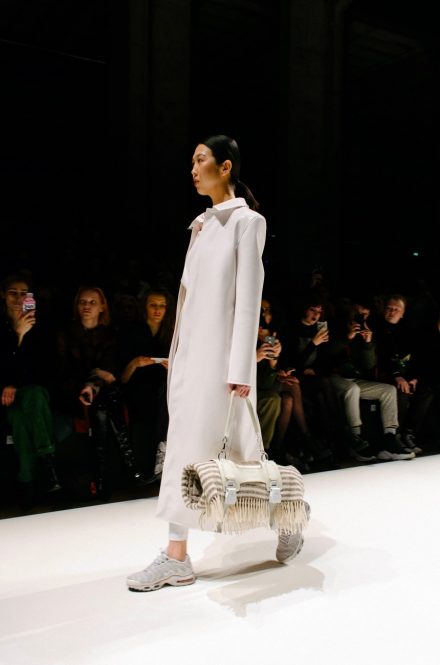
Between sips of hot chocolate from a cup of the daintiest china, Margot Charbonnier talks me through the corpus of her conceptual brainchild, Sample-CM. With a focus on “considering clothes as pieces of design intended for wear and practice”, her work blurs the often rigid boundaries of institutionalised creativity, passing fashion, art and architecture through a sociological grinder. Offering collections and projects that leave the beholder in a state of inquisitive admiration, she forces us to reconsider and question the role that fashion plays in both social and physical space. But such an inter-disciplinary approach may seem unorthodox under the somewhat conservative gaze of the mainstream fashion sphere, and so arises the obstacle that Margot must consistently encounter .
Her entry into the world of ready-to-wear came during Berlin Alternative Fashion Week 2015, tumbling headlong into the spotlight with a capsule collection presented under the moniker, ‘Grand Bassin’. Memorable for its innovative blending of the practicality and technical consideration synonymous with sportswear, and the decorative codes of high fashion, the collection was successful in calling attention to the tenuous equilibriums upon which fashion sits, situating it simultaneously within spheres of aesthetic fascination and appreciation, and within contexts defined by technicality and active spatial interaction.
The collection’s fulcrum takes form in the idiosyncratic use of Kinesio Tape, a material used in physiotherapeutic practice to aid in the healing of muscles. But how does a material with such a definite practical use find itself as an integral component of a ready-to-wear collection presented during fashion week? “I wanted to […] consider the garment as a body, using this tape to transform the garment. Sometimes it’s only decorative, sometimes it has a real practical purpose, changing the shape or size of the garment”. Indeed, in offering the wearer such agency over the garment, the wearer is able to change both their and the garment’s interaction with surrounding physical and social contexts. The simple adjusting of a strap transforms the look, and subsequently its perceived meaning, forcing the wearer to truly consider how they use fashion in broadcasting themselves before jumping into the deep end.
This experimental, albeit sociologically considered, approach to fashion has lead to Margot earning a reputation as a creative who refuses to be defined within the prescriptive boxes that contemporary cultural discourse necessitates. Such a dynamic attitude towards creativity has been creeping into vogue; after all, “it has been really trendy for a couple of years to be an inter-disciplinarian” across a variety of creative fields and so it makes sense that this enlightened approach is beginning to present itself in the fashion sphere. However, if inter-disciplinarity in fashion is becoming a trend, then it is one that Margot vehemently bucks. In her case, it does not equate to a blind indulgence in numerous creative fields, but rather to an observing, documenting and questioning of performative social phenomena using a variety of techniques.
But from where does such a socially intuitive approach to fashion creation stem? Prior to her fashion education at the prestigious Duperré in Paris and London’s world-renowned Central Saint Martins, Margot completed her first degree in sociology. When asked how, if at all, her sociological grounding has affected or influenced her approach to fashion, she asserts that it sparked her interest in the sociology of the body, as well as allowing her to consider clothing “not merely as beautiful, [but] as design”. Architectural consideration of the garment forms a key part of all of her projects, with the garment’s full effect only seen in action. “I’m really interested in the ritualistic aspect of […] doing something with a garment, practicing and changing it”; it is here, in the notion of practicing clothing, of acting out its visual, physical and social potential, that fashion’s beauty lies. After all, to deny or ignore the functional intentions of a garment, that it is to be worn, would be most erroneous. These taken into account, the ‘beauty’ of fashion can only truly exist in a space in which its real practical application is accounted for.
With regard to the prevalence of such an approach in the current fashion climate, Margot feels that “though fashion [remains to be] considered as design, […] [it] is opening up”. Though it may be her relocating to Berlin that has led to such an optimistic view on the extent to which fashion is becoming aware of its extenuating creative circumstances. “[Here in Berlin], […] it seems that people don’t really pay attention to [concrete] definitions. […] I feel much more freedom”. It does, however, certainly stand true that all that glitters is not gold; though it may be world-renowned for its creative dynamism, Berlin is a city that moves at such a fast, and at times erratic pace, that what grasps attention one day is soon forgotten the next.
In Margot’s case however, this will not be an issue to take into consideration any time soon. With such a heavy emphasis placed on the ways in which clothes are worn, her work appeals to what are perhaps the most integral components of fashion; the individual and their interactions with surrounding spaces and contexts. We certainly look forward to seeing more from Sample-CM, whose next collection will be presented at January’s Mercedes-Benz Fashion Week here in Berlin. Keep a close eye on this space, if only to witness the ways in which Margot warps its boundaries next.




